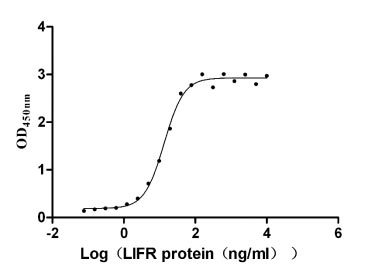Recombinant Human Lysophosphatidic acid receptor 5 (LPAR5), partial
-
货号:CSB-YP013051HU1
-
规格:
-
来源:Yeast
-
其他:
-
货号:CSB-EP013051HU1
-
规格:
-
来源:E.coli
-
其他:
-
货号:CSB-EP013051HU1-B
-
规格:
-
来源:E.coli
-
共轭:Avi-tag Biotinylated
E. coli biotin ligase (BirA) is highly specific in covalently attaching biotin to the 15 amino acid AviTag peptide. This recombinant protein was biotinylated in vivo by AviTag-BirA technology, which method is BriA catalyzes amide linkage between the biotin and the specific lysine of the AviTag.
-
其他:
-
货号:CSB-BP013051HU1
-
规格:
-
来源:Baculovirus
-
其他:
-
货号:CSB-MP013051HU1
-
规格:
-
来源:Mammalian cell
-
其他:
产品详情
-
纯度:>85% (SDS-PAGE)
-
基因名:
-
Uniprot No.:
-
别名:LPAR5; GPR92; GPR93; Lysophosphatidic acid receptor 5; LPA receptor 5; LPA-5; G-protein coupled receptor 92; G-protein coupled receptor 93
-
种属:Homo sapiens (Human)
-
蛋白长度:Partial
-
蛋白标签:Tag type will be determined during the manufacturing process.
The tag type will be determined during production process. If you have specified tag type, please tell us and we will develop the specified tag preferentially. -
产品提供形式:Lyophilized powder
Note: We will preferentially ship the format that we have in stock, however, if you have any special requirement for the format, please remark your requirement when placing the order, we will prepare according to your demand. -
复溶:We recommend that this vial be briefly centrifuged prior to opening to bring the contents to the bottom. Please reconstitute protein in deionized sterile water to a concentration of 0.1-1.0 mg/mL.We recommend to add 5-50% of glycerol (final concentration) and aliquot for long-term storage at -20℃/-80℃. Our default final concentration of glycerol is 50%. Customers could use it as reference.
-
储存条件:Store at -20°C/-80°C upon receipt, aliquoting is necessary for mutiple use. Avoid repeated freeze-thaw cycles.
-
保质期:The shelf life is related to many factors, storage state, buffer ingredients, storage temperature and the stability of the protein itself.
Generally, the shelf life of liquid form is 6 months at -20°C/-80°C. The shelf life of lyophilized form is 12 months at -20°C/-80°C. -
货期:Delivery time may differ from different purchasing way or location, please kindly consult your local distributors for specific delivery time.Note: All of our proteins are default shipped with normal blue ice packs, if you request to ship with dry ice, please communicate with us in advance and extra fees will be charged.
-
注意事项:Repeated freezing and thawing is not recommended. Store working aliquots at 4°C for up to one week.
-
Datasheet :Please contact us to get it.
相关产品
靶点详情
-
功能:Receptor for lysophosphatidic acid (LPA), a mediator of diverse cellular activities.
-
基因功能参考文献:
- It signaling may play a key role in the mechanisms underlying neuropathic pain following demyelination in the brain. PMID: 29409686
- These results suggest that the cell motile activity is regulated through the induction of LPA5 by phorbol ester and anticancer drug treatments in A375cells. PMID: 29309788
- These results suggest that the diverse roles of LPA4, LPA5 and LPA6 are involved in the activation of tumor progression in pancreatic cancer cells. PMID: 25849892
- Down-regulation of LPA receptor 5 contributes to aberrant LPA signalling in EBV-associated nasopharyngeal carcinoma. PMID: 25294670
- MMP-2 and MMP-9 were found in HT1080L5 cells, in comparison with control cells. These results suggest that LPA signaling via LPA5 negatively regulates the cell motile and invasive activities of human sarcoma cells. PMID: 24676544
- These results suggest that LPA5 may act as a negative regulator of cellular responses in mouse fibroblast 3T3 cells, similar to the case for LPA1. PMID: 24632199
- It was shown that lysophosphatidic acid 5 receptor transactivated the epidermal growth factor receptor and that inhibition of epidermal growth factor receptor blocked lysophosphatidic acid 5 receptor-dependent activation of NHE3. PMID: 21832242
- LPA5 is a bona fide LPA receptor on human mast cells responsible for the majority of LPA induced MIP-1beta release. PMID: 21464938
- LPA4 and LPA5 receptors induce osteoblastic differentiation of human mesenchymal stem cells PMID: 20069565
- Data show that CLL cells express LPA receptors LPA(1-5) and VEGF receptors, and the plasma levels of VEGF are elevated in CLL patients. PMID: 19860625
- GPR92 is proposed as a fifth LPA receptor, LPA5, which likely has distinct physiological functions in view of its expression pattern. PMID: 16774927
- FPP and NAG play a role in the sensory nervous system through activation of GPR92 PMID: 18499677
- Four residues involved in ligand recognition in LPA(5) were identified as follows: R2.60N mutant abolished receptor activation, whereas H4.64E, R6.62A, and R7.32A greatly reduced receptor activation. PMID: 19366702
显示更多
收起更多
-
亚细胞定位:Cell membrane; Multi-pass membrane protein.
-
蛋白家族:G-protein coupled receptor 1 family
-
组织特异性:Not expressed in frontal cortex, basal forebrain, caudate putamen, thalamus, or hippocampus.
-
数据库链接:
HGNC: 13307
OMIM: 606926
KEGG: hsa:57121
STRING: 9606.ENSP00000327875
UniGene: Hs.155538
Most popular with customers
-
Recombinant Human Leukemia inhibitory factor receptor (LIFR), partial (Active)
Express system: Mammalian cell
Species: Homo sapiens (Human)
-
Recombinant Human C-X-C chemokine receptor type 4 (CXCR4)-VLPs (Active)
Express system: Mammalian cell
Species: Homo sapiens (Human)
-
Recombinant Mouse Retinol-binding protein 4 (Rbp4) (Active)
Express system: Mammalian cell
Species: Mus musculus (Mouse)
-
Recombinant Human Somatostatin receptor type 2 (SSTR2)-VLPs (Active)
Express system: Mammalian cell
Species: Homo sapiens (Human)
-
Recombinant Human Claudin-4 (CLDN4)-VLPs (Active)
Express system: Mammalian cell
Species: Homo sapiens (Human)
-
Recombinant Human Complement component C1q receptor (CD93), partial (Active)
Express system: Mammalian cell
Species: Homo sapiens (Human)
-
Recombinant Human Alkaline phosphatase, germ cell type (ALPG) (Active)
Express system: Mammalian cell
Species: Homo sapiens (Human)
-
Recombinant Human Cadherin-1(CDH1),partial (Active)
Express system: Mammalian cell
Species: Homo sapiens (Human)



-AC1.jpg)
















